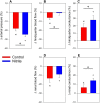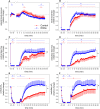Low dose nitrite improves reoxygenation following renal ischemia in rats
- PMID: 29097777
- PMCID: PMC5668317
- DOI: 10.1038/s41598-017-15058-5
Low dose nitrite improves reoxygenation following renal ischemia in rats
Erratum in
-
Publisher Correction: Low dose nitrite improves reoxygenation following renal ischemia in rats.Sci Rep. 2018 Jan 24;8(1):1748. doi: 10.1038/s41598-018-19651-0. Sci Rep. 2018. PMID: 29367591 Free PMC article.
Abstract
In hypoxic and acidic tissue environments, nitrite is metabolised to nitric oxide, thus, bringing about novel therapeutic options in myocardial infarction, peripheral artery disease, stroke, and hypertension. Following renal ischemia, reperfusion of the kidney remains incomplete and tissue oxygenation is reduced for several minutes to hours. Thus, in renal ischemia-reperfusion injury, providing nitrite may have outstanding therapeutic value. Here we demonstrate nitrite's distinct potential to rapidly restore tissue oxygenation in the renal cortex and medulla after 45 minutes of complete unilateral kidney ischemia in the rat. Notably, tissue oxygenation was completely restored, while tissue perfusion did not fully reach pre-ischemia levels within 60 minutes of reperfusion. Nitrite was infused intravenously in a dose, which can be translated to the human. Specifically, methaemoglobin did not exceed 3%, which is biologically negligible. Hypotension was not observed. Providing nitrite well before ischemia and maintaining nitrite infusion throughout the reperfusion period prevented the increase in serum creatinine by ischemia reperfusion injury. In conclusion, low-dose nitrite restores renal tissue oxygenation in renal ischemia reperfusion injury and enhances regional kidney post-ischemic perfusion. As nitrite provides nitric oxide predominantly in hypoxic tissues, it may prove a specific measure to reduce renal ischemia reperfusion injury.
Conflict of interest statement
The authors declare that they have no competing interests.
Figures



Similar articles
-
The targets of β-sitosterol as a novel therapeutic against cardio-renal complications in acute renal ischemia/reperfusion damage.Naunyn Schmiedebergs Arch Pharmacol. 2021 Mar;394(3):469-479. doi: 10.1007/s00210-020-01984-1. Epub 2020 Oct 13. Naunyn Schmiedebergs Arch Pharmacol. 2021. PMID: 33048170
-
Low-dose nitrite alleviates early effects of an X-ray contrast medium on renal hemodynamics and oxygenation in rats.Invest Radiol. 2014 Feb;49(2):70-7. doi: 10.1097/RLI.0b013e3182a6fea6. Invest Radiol. 2014. PMID: 24056115
-
Nitrite-derived nitric oxide protects the rat kidney against ischemia/reperfusion injury in vivo: role for xanthine oxidoreductase.J Am Soc Nephrol. 2007 Feb;18(2):570-80. doi: 10.1681/ASN.2006050450. Epub 2007 Jan 3. J Am Soc Nephrol. 2007. PMID: 17202421
-
Effects of nitrite on modulating ROS generation following ischemia and reperfusion.Adv Drug Deliv Rev. 2009 Apr 28;61(4):339-50. doi: 10.1016/j.addr.2009.02.002. Adv Drug Deliv Rev. 2009. PMID: 19385092 Review.
-
Prospects of antisense oligodeoxynucleotides to alleviate renal ischaemia-reperfusion injury.Expert Opin Biol Ther. 2004 Dec;4(12):1931-7. doi: 10.1517/14712598.4.12.1931. Expert Opin Biol Ther. 2004. PMID: 15571455 Review.
Cited by
-
Trinitroglycerine-loaded chitosan nanoparticles attenuate renal ischemia-reperfusion injury by modulating oxidative stress.Sci Rep. 2024 Dec 30;14(1):32112. doi: 10.1038/s41598-024-83886-3. Sci Rep. 2024. PMID: 39738455 Free PMC article.
-
Magnetic resonance imaging of renal oxygenation.Nat Rev Nephrol. 2025 Jul;21(7):483-502. doi: 10.1038/s41581-025-00956-z. Epub 2025 Apr 23. Nat Rev Nephrol. 2025. PMID: 40269325 Review.
-
Quantitative Assessment of Renal Perfusion and Oxygenation by Invasive Probes: Basic Concepts.Methods Mol Biol. 2021;2216:89-107. doi: 10.1007/978-1-0716-0978-1_6. Methods Mol Biol. 2021. PMID: 33475996 Free PMC article.
-
Reversible (Patho)Physiologically Relevant Test Interventions: Rationale and Examples.Methods Mol Biol. 2021;2216:57-73. doi: 10.1007/978-1-0716-0978-1_4. Methods Mol Biol. 2021. PMID: 33475994 Free PMC article.
-
Nitric oxide delivery using nitric oxide-containing fluid in continuous hemofiltration: an in vitro study.J Artif Organs. 2022 Mar;25(1):66-71. doi: 10.1007/s10047-021-01284-2. Epub 2021 Jun 23. J Artif Organs. 2022. PMID: 34160716
References
Publication types
MeSH terms
Substances
LinkOut - more resources
Full Text Sources
Other Literature Sources
Medical
Research Materials

